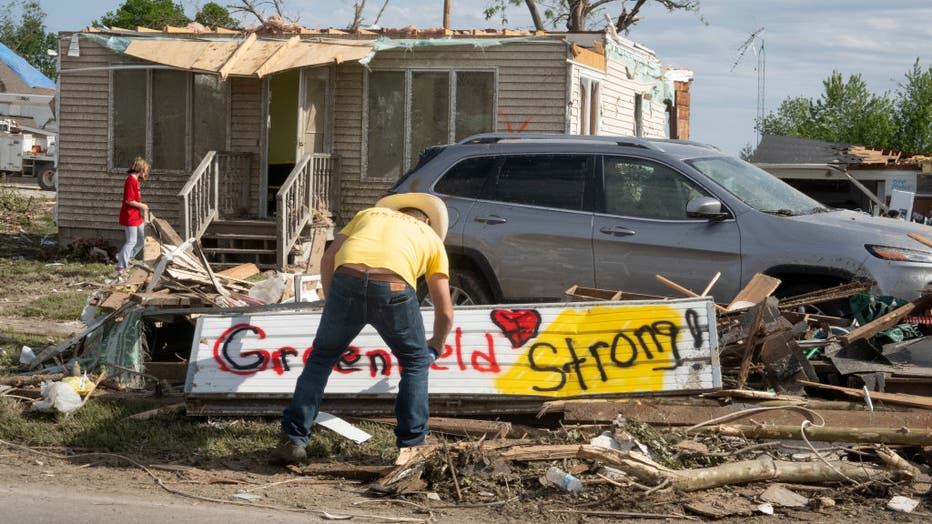22 dead in Memorial Day weekend storms across multiple states
At least 7 killed in Texas tornado outbreak
At least 7 people are dead, including at least two children, and at least 100 people have been injured after reported tornadoes in Cooke, Collin and Denton counties on Saturday night. No one is believed to be missing at this time. Texas Governor Greg Abbott came to Cooke County on Sunday, the area that was the hardest hit. He issued a disaster declaration for the affected counties.
A series of powerful storms swept over the central and southern U.S. over the Memorial Day holiday weekend, killing at least 22 people and leaving a wide trail of destroyed homes, businesses, and power outages.
Memorial Day weekend storm deaths in Texas, Oklahoma, Arkansas, and Kentucky
The destructive storms caused deaths in Texas, Oklahoma, Arkansas, and Kentucky. These regions were just north of an oppressive, early-season heat wave setting records from south Texas to Florida.
In Kentucky, Gov. Andy Beshear, who earlier declared a state of emergency, reported five fatalities in his state. One of the victims, a 54-year-old man, suffered a heart attack while cutting fallen trees in Caldwell County in western Kentucky, according to the governor’s office.
Severe weather warnings for the East Coast on Memorial Day
Forecasters warned that the severe weather could shift to the East Coast later Monday. With millions of people outdoors for the holiday, officials urged everyone to remain vigilant and watch the skies. A tornado watch was issued, covering areas from North Carolina to Maryland.
The death toll of 22 included seven deaths in Cooke County, Texas, from a Saturday tornado that tore through a mobile home park, officials said. Arkansas reported eight deaths due to the storm.

A resident assesses the damage in Greenfield, Missouri, after a series of powerful storms devastated the area over the Memorial Day weekend, leaving a path of destruction and loss. (Photo by Scott Olson/Getty Images)
In Mayes County, Oklahoma, two people lost their lives. The storm disrupted an outdoor wedding, causing injuries among the guests.
Over 400,000 customers across the eastern U.S. were without power Monday afternoon, including about 125,000 in Kentucky. Twelve states reported at least 10,000 outages earlier in the day, according to PowerOutage.us.
Power outages in the eastern U.S. on Memorial Day
The area on Monday's highest alert for severe weather spans from Alabama to New York. President Joe Biden sent condolences to the families of those who died and stated that the Federal Emergency Management Agency (FEMA) is on the ground conducting damage assessments. He has contacted governors to determine the federal support they might need.
Recent tornadoes and severe weather impact
It's been a grim month of tornadoes and severe weather in the nation’s midsection. Tornadoes in Iowa last week left at least five people dead and dozens injured. Storms killed eight people in Houston earlier this month.
The severe thunderstorms and deadly twisters have occurred during a historically bad season for tornadoes, exacerbated by climate change. April had the second-highest number of tornadoes on record in the country.
Harold Brooks, a senior scientist at the National Severe Storms Laboratory in Norman, said a persistent pattern of warm, moist air is to blame for the string of tornadoes over the past two months.
Extreme heat contributes to severe weather
That warm, moist air is at the northern edge of a heat dome, bringing temperatures typically seen at the height of summer to late May.
The heat index—a combination of air temperature and humidity that indicates how hot the human body feels—neared triple digits in south Texas on Monday. Extreme heat was also forecast for San Antonio and Dallas.
In Florida, Melbourne and Ft. Pierce set new daily record highs on Monday, hitting 98°F (36.7°C). Miami set a record high of 96°F (35.5°C) on Sunday.
The Associated Press contributed to this story. It was reported from Los Angeles.

